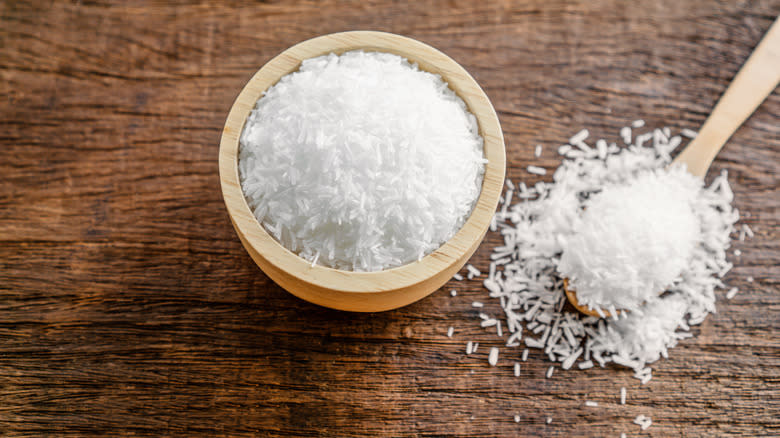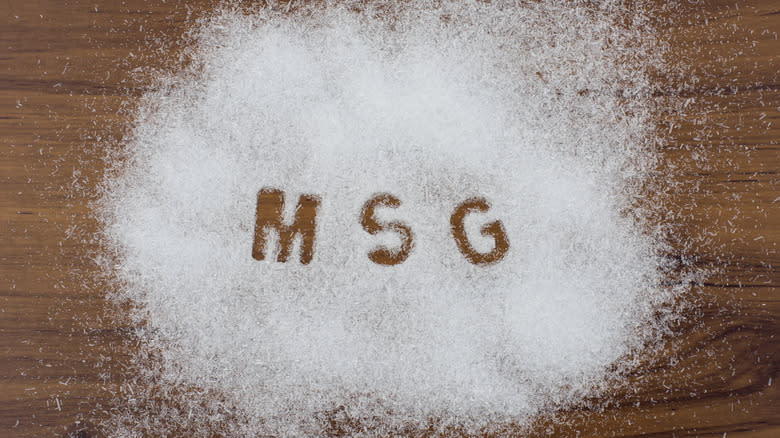How Are You Meant To Use MSG In Cooking?

Flavor fanatics, listen closely; we're here to give you the ultimate rundown for cooking with monosodium glutamate, commonly known as MSG. A culinary secret weapon known for its savory spirit and flavor-enhancing properties, MSG is a derivative of an amino acid found in various foods like tomatoes and cheese. Although not as common in the United States as it is in other parts of the world, there are plenty of reasons to start incorporating it into your favorite recipes. But first, you'll need to know how exactly to use it to maximize its benefits.
When it comes to ingredients rich with umami flavors, you'll want to use them sparingly. The same reason you wouldn't drench your food with soy sauce is the same reason you shouldn't overdo it with MSG -- a little bit goes a long way. Begin with a small amount; ¼ or ½ of a teaspoon is a good place to start, and you can always add more if you're hungry for more flavor.
MSG works best with savory foods, and it's not to be used as a salt substitute. So, if you're considering using MSG in your grandma's sea salt brownie recipe -- don't. When you are, however, cooking a savory dish and want to utilize MSG, incorporate the same spices and aromatics that you typically do -- MSG is designed to bolster their flavors for a more vibrant dining experience.
Read more: 14 Liquids To Add To Scrambled Eggs (And What They Do)
MSG Myth Busting

You may have previously heard of MSG, not because of the many ways it can benefit your favorite recipes but rather due to some of the misconceptions surrounding it. Let's bust some MSG myths so you can use it in your kitchen without thinking twice.
Some individuals claim to experience headaches and other unwelcome symptoms after consuming food containing MSG. However, scientific studies have failed to consistently support these claims, and the symptoms are more likely attributable to factors like psychological expectations and other ingredients. In fact, the United States Food & Drug Administration recognizes MSG as "generally safe."
MSG has significantly less sodium than regular table salt, which contributes to cardiovascular disease when consumed in excess, according to The Washington Post. Although it's been stigmatized, MSG is an excellent option for reducing your sodium intake as it enhances the flavor of your food while giving it subtly salty undertones and a prominent umami richness.
Dishes MSG Works Best In

MSG is a powerhouse in savory recipes, so if you're making a hearty breakfast, brunch, lunch, or dinner, this underrated flavor enhancer will take your dishes to tasty new heights. It brings a bold depth to bland boxed broths, so whether you're whipping up chicken noodle soup to ease a cold or brewing beef stew for a filling dinner, MSG can give it a more prominent flavor.
You can also use MSG to elevate the flavors in your go-to stir-fry recipes, as it will complement the dish's various other ingredients. Introduce MSG to a batch of gravy and pour it atop a heaping pot of mashed potatoes to liven up the inherently neutral flavor of smashed spuds. Because umami is frequently associated with meaty flavors, MSG can be particularly useful in vegetarian and vegan recipes, giving them a heartier flavor without the use of animal products.
When it comes to applying MSG to your savory recipes, don't limit yourself. Whether it's breakfast sandwiches, roasted vegetables, or Thanksgiving stuffing, this one-of-a-kind flavor enhancer is worth keeping in your pantry.
Read the original article on Daily Meal.

